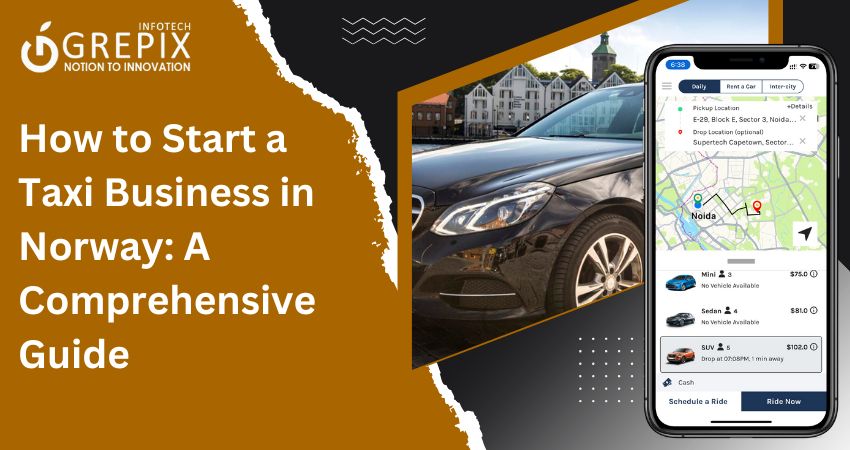How to Start a Taxi Business in Norway: A Comprehensive Guide
The taxi industry in Norway is a dynamic and growing sector, offering promising opportunities for entrepreneurs. With increasing demand for reliable and eco-friendly transportation, now is the perfect time to establish your taxi business. However, achieving success in this competitive landscape requires thorough planning, regulatory compliance, and a well-defined business strategy.
Starting a taxi business in Norway involves navigating regulations, understanding market trends, and implementing effective operational strategies. By embracing sustainability, utilizing modern technology, and providing top-tier service, you can build a thriving business. This comprehensive guide will walk you through every step, from legal requirements to marketing strategies, to help you launch and grow a successful taxi service in Norway.
The taxi industry in Norway is expanding, offering lucrative opportunities for entrepreneurs seeking to provide reliable and eco-friendly transportation. Success in this competitive market requires thorough planning, compliance with legal regulations, and the adoption of advanced technology. Key steps include obtaining the necessary licenses, building a sustainable fleet, hiring professional drivers, and leveraging digital tools for bookings and payments. Marketing strategies, financial management, and sustainability initiatives further contribute to business growth. With the right approach, entrepreneurs can establish a thriving taxi service. Grepix Infotech offers innovative taxi app solutions to streamline operations and enhance customer experience in Norway.
1Understanding the Norway Taxi Industry
The Norwegian taxi sector is influenced by changing consumer demands and strict government regulations.Urban centers like Oslo and Bergen experience high taxi demand, especially during rush hours and major events. With Norway’s commitment to sustainability, electric and hybrid taxis are becoming increasingly popular.
2Legal Requirements for Starting a Taxi Business
Business Licensing
To operate legally, you must register your business with the Brønnøysund Register Centre. Choose a suitable business structure, such as a sole proprietorship or a limited company, and comply with Norway’s business regulations.
Taxi Licenses and Regulations
A taxi license from the Norwegian Road Transport Authority is mandatory. This requires meeting strict criteria, including vehicle inspections and driver qualifications. Local regulations may differ by municipality, so thorough research is essential.
Insurance Requirements
Insurance is a crucial aspect of running a taxi business. Essential policies include vehicle insurance for accident coverage, public liability insurance to protect against passenger claims and employee insurance if you hire drivers. These policies help safeguard your business and ensure legal compliance.
3Creating a Business Plan
Market Research and Analysis
Understanding your target audience and competitors is key. Determine whether your primary customers will be commuters, tourists, or corporate clients, as this will shape your services and pricing strategy.
Financial Planning
A well-structured financial plan is essential for long-term success. Estimate costs for vehicle purchases or leases, licensing, and technology, such as booking systems. Project your revenue based on expected ridership and pricing to develop a sustainable financial strategy.
Business Model and Branding
Decide whether to own your fleet or collaborate with independent drivers. Establish a strong brand identity that conveys professionalism and reliability to attract and retain customers.
4Choosing the Right Fleet
Selecting Vehicles
With Norway’s focus on sustainability, electric and hybrid taxis are ideal choices. Consider comfort, fuel efficiency, and passenger capacity when selecting your vehicles.
Maintenance and Safety Standards
Regular maintenance ensures your fleet remains in excellent condition. Prioritize vehicle safety to comply with regulations and provide a reliable service to passengers.
5Hiring and Training Drivers
Driver Qualifications
Professional drivers must hold a valid license and meet local requirements, including background checks and health assessments.
Training Programs
Invest in comprehensive training programs to ensure high service standards. Focus on customer service, local route knowledge, and emergency response preparedness. Regular training helps maintain a skilled and professional team.
6Setting Up Technology and Operations
Booking and Dispatch Systems
A reliable booking and dispatch system is essential. GPS-enabled apps like TaxiCaller or a custom-built platform can streamline ride requests and improve efficiency.
Payment Systems
Cashless payments dominate Norway’s transportation sector. Equip taxis with systems that support credit/debit cards, mobile payments, and app-based transactions to enhance convenience and customer trust.
Managing Operations
Establish an efficient operational structure, including driver shifts, vehicle availability, and customer support. Automating certain processes can significantly improve efficiency and service quality.
Also Read: "Top Ride-Sharing Taxi Apps in Norway"
7Marketing Your Taxi Business
Online Marketing Strategies
A strong digital presence is crucial. Develop an SEO-optimized website and maintain active social media profiles on platforms like Facebook and Instagram. Use Google Ads to target local customers searching for taxi services.
Building Partnerships
Collaborate with hotels, airports, and event organizers to secure consistent business. Strategic partnerships can expand your customer base and boost credibility.
Customer Retention
Loyalty programs and special discounts can encourage repeat business. Providing excellent service ensures customer satisfaction and positive word-of-mouth referrals.
8Managing Finances and Taxes
Accounting Software
Use accounting tools like Xero or QuickBooks to track income, expenses, and profits. Keeping detailed financial records ensures tax compliance and financial stability.
Tax Obligations
If your revenue exceeds the required threshold, you must register for Value Added Tax (VAT). Additionally, file annual income tax returns and ensure payroll taxes are properly managed if you employ drivers.
9Sustainability in the Taxi Business
Adopting Green Practices
Sustainability is a competitive advantage in Norway. Transitioning to electric or hybrid vehicles and optimizing fuel consumption can reduce environmental impact and attract eco-conscious customers.
Government Incentives
Norwegian authorities provide subsidies for electric vehicle adoption and infrastructure. Research available grants and incentives to help offset costs.
Overcoming Common Challenges
Running a taxi business comes with challenges such as licensing delays, competition from ride-hailing apps, and high operational costs. Address these by:
- `
- Ensuring full regulatory compliance
- Differentiating through superior service quality
- Optimizing operations to control expenses
10Future Trends in the Taxi Industry
Norway’s taxi industry is set to evolve with advancements in electric and autonomous vehicles. AI-powered dispatch systems and digital innovations will reshape operations. Staying informed about these trends will help keep your business competitive.
Conclusion
Starting a taxi business in Norway presents an excellent opportunity, driven by the increasing demand for sustainable and efficient transportation solutions. Grepix Infotech, a leading taxi app development company, is your ideal partner in launching a seamless and successful taxi service. Our cutting-edge solutions, including intuitive booking apps, GPS-powered dispatch systems, and secure cashless payment options, ensure an optimized and customer-friendly experience.
Success in Norway’s competitive taxi industry relies on sustainability, compliance, and exceptional service. With Grepix Infotech’s expertise, you can build a modern, scalable, and customer-centric taxi business that thrives in Norway’s evolving transportation landscape.
FAQs
1. How much does it cost to start a taxi business in Norway?
The startup costs depend on fleet size and operational scale, typically ranging from NOK 500,000 to NOK 2,000,000 for initial setup, including licensing, vehicles, and technology integration.
2. How long does it take to obtain a taxi license in Norway?
The licensing process can take several months, depending on compliance with regulatory requirements and processing times by local authorities.
3. Can I start a taxi business with a single vehicle, or do I need a fleet?
Yes, you can begin with a single taxi, especially in smaller markets, and gradually expand as demand increases.
4. What types of insurance are required for taxi operators in Norway?
Taxi operators must have vehicle insurance, public liability insurance, and employee insurance for hired drivers to ensure full legal compliance and protection.
5. Are there any government incentives for electric taxi businesses?
Yes, Norway provides various incentives for electric taxis, including government grants, tax reductions, and free access to charging stations, promoting sustainable transportation solutions.
Looking out to start your own venture like inDrive? Try out our HireMe Taxi inDriver Clone, the easiest way to kick-start your taxi business.








